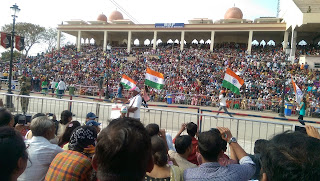On the last day of the tour, we visited three important places - one of historical importance and one the place of pride for every Indian. Wanted to visit these places right from the school days as learn about them in the history book and was attached sentimentally to these places. During the day, we went through the different states of mind - very satisfied after the darshan in the Golden Temple, irritated and anguished after visiting Jalianwala Bagh and filled with enthusiasm and national pride after the Attari Parade by Border Security Force .
Shri Harmandir Saheb Golden Temple, Amritsar |
| Myself in front of a 360-foot high flag post |
Guru Arjan Sahib, the Fifth Sikh Guru, conceived the idea of creating a central place of worship for the Sikhs and he himself designed the architecture of Sri Harmandir Sahib.
Spent about 3 hours in this magnificent temple constructed after excavating the holy tank (Amritsar or Amrit Sarovar). Impressed with well-equipped with facilities and discipline by the devotees. Was reading about the Golden Temple since school-days and especially after visiting in Huzursahib, Nanded. Would have spent more time but could not as we have to reach Attari Border before 3 pm.
Jalianwala Bagh Massacre, Amritsar took place on 13 April 1919 when British troops under the command of Colonel Reginald Dyer fired rifles into a crowd. The civilians had assembled for Baisakhi which marks the Sikh new year and commemorates the formation of Khalsa panth of warriors under Guru Gobind Singh in 1699.
The Jallianwalla Bagh is a public garden of 6 to 7 acres (2.8 ha), walled on all sides, with five entrances. Dyer stated that approximately 1,650 rounds had been fired 379 identified dead, with approximately 1,100-1500 wounded. This "brutality stunned the entire nation", resulting in the Non-cooperation Movement of 1920–22. Some historians consider the episode a decisive step towards the end of British rule in India.
The visit to the Bagh made us remember one of the most horrible events of India's independence struggle and we all were speechless while looking at the signs of the massacre.
 |
| Bullet marks showing that the firing was done above the waist to cause maximum casualty |
 |
| Martyrs well where in 120 bodies were recovered after the massacre |
 |
| This was the narrow lane which was blocked by British |
 |
| Lowering of the flags at Attari |
 |
| Mrs. Kelkar ann Sadhana in front of a 360-foot high flag post |

































No comments:
Post a Comment